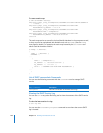
218 Chapter 14 Working with Network Services
inetd and xinetd each have their own configuration files. inetd uses one file,
inetd.conf, to map a given service to its executable. All standard services that inetd
handles are already listed in the file.
xinetd, on the other hand, uses a different
configuration file for each service it provides. In the
/etc/xinetd.d folder, there are
configuration files for each of the services that xinetd handles. If you were to enable
ftp sharing, Mac OS X will modify the configuration file /etc/xinetd.d/ftp. For more
information about xinetd, see www.xinetd.org.
Managing the DHCP Service
Dynamic Host Configuration Protocol (DHCP) service lets you administer and distribute
IP addresses and other configuration information to client computers from your server.
When you configure the DHCP server, you assign a block of IP addresses that can be
made available to clients. Each time a client computer configured to use DHCP starts
up, it looks for a DHCP server on your network. If a DHCP server is found, the client
computer requests an IP address. The DHCP server checks for an available IP address
and sends it to the client computer along with a “lease period” (the length of time the
client computer can use the address) and configuration information.
Starting and Stopping DHCP Service
To start DHCP service:
$ sudo serveradmin start dhcp
To stop DHCP service:
$ sudo serveradmin stop dhcp
Checking the Status of DHCP Service
To see summary status of DHCP service:
$ sudo serveradmin status dhcp
To see detailed status of DHCP service:
$ sudo serveradmin fullstatus dhcp
Viewing DHCP Service Settings
To list DHCP service configuration settings:
$ sudo serveradmin settings dhcp
To list a particular setting:
$ sudo serveradmin settings dhcp:
setting
To list a group of settings:
You can list a group of settings that have part of their names in common by typing
only as much of the name as you want, stopping at a colon (:), and typing an asterisk
(*) as a wildcard for the remaining parts of the name. For example:
$ sudo serveradmin settings dhcp:subnets:*


















